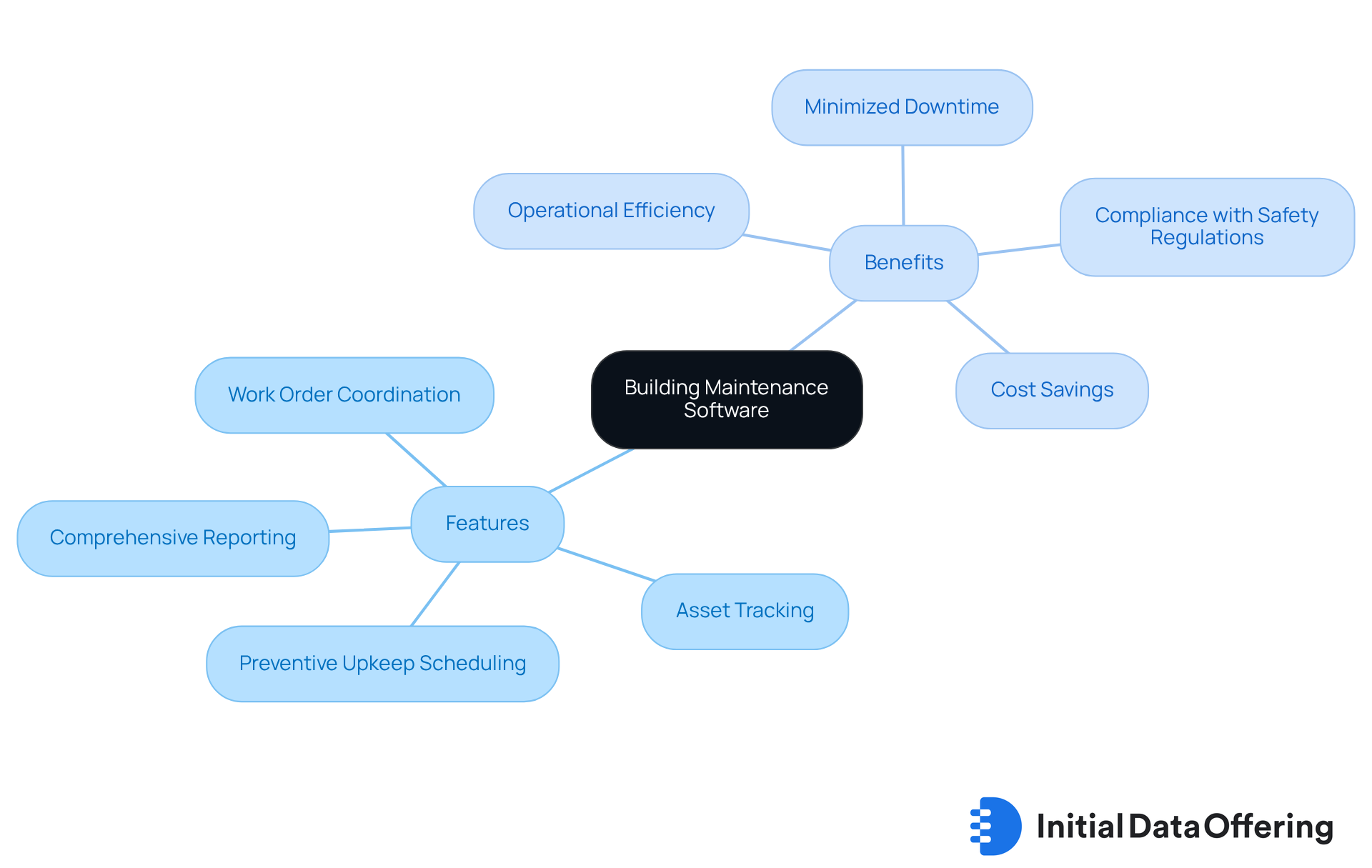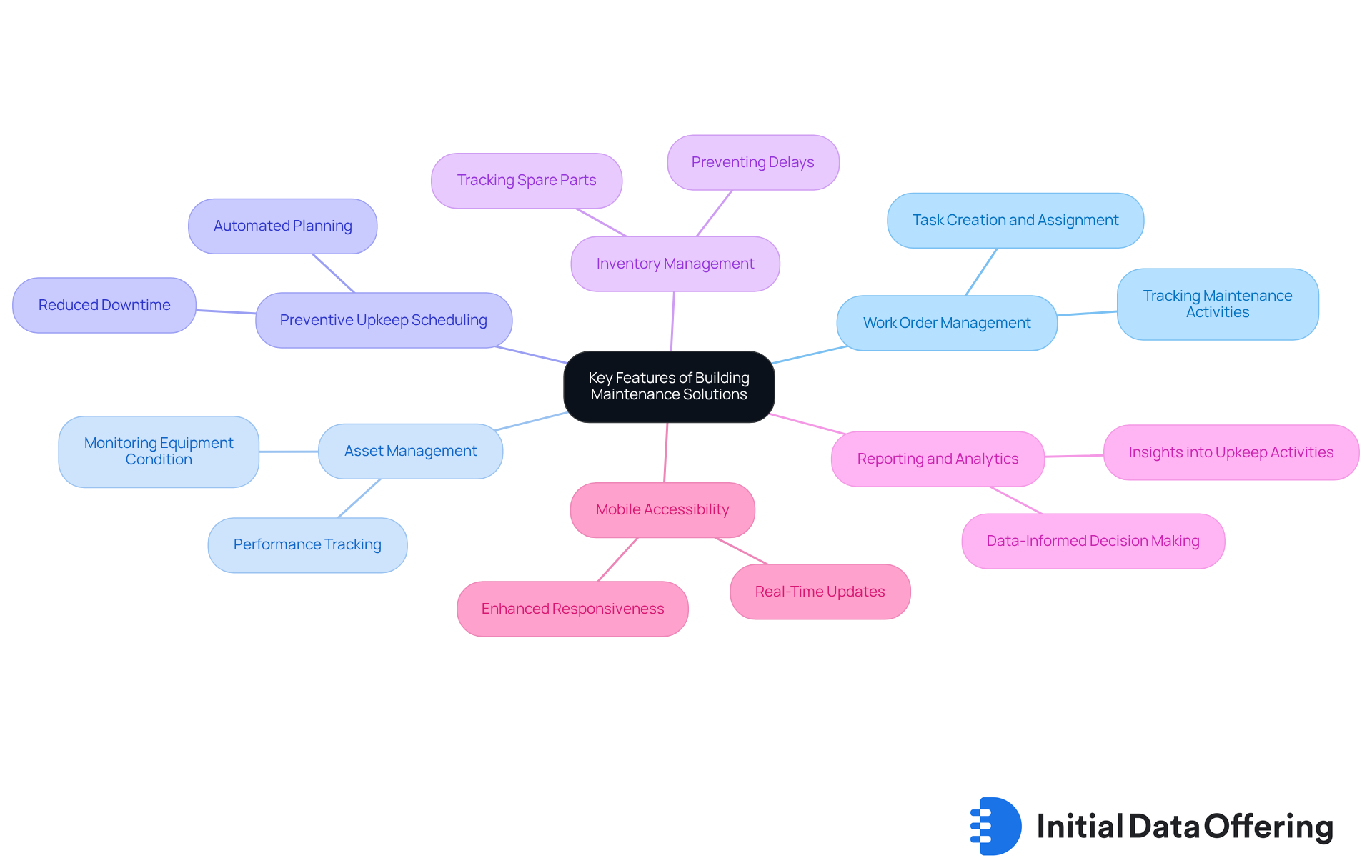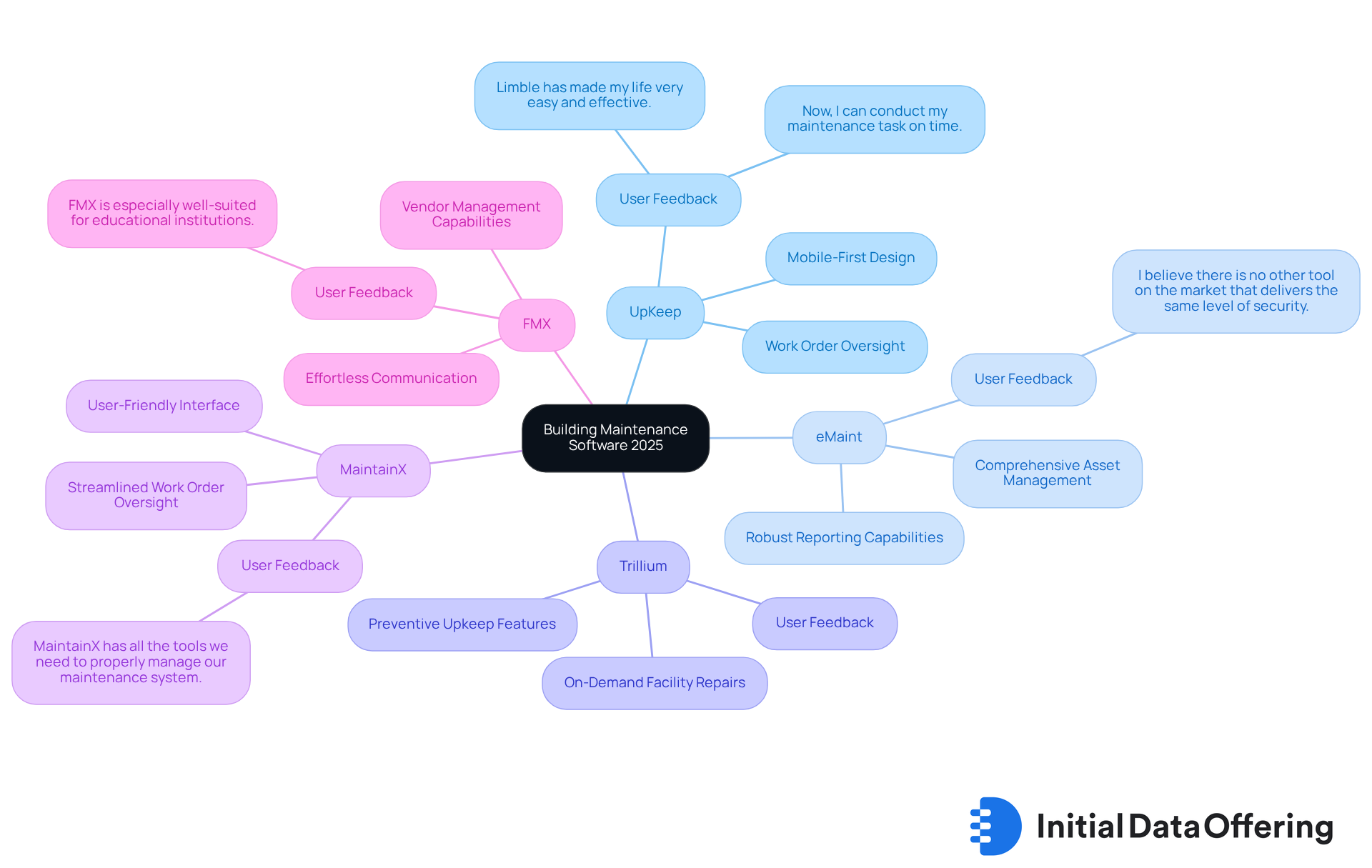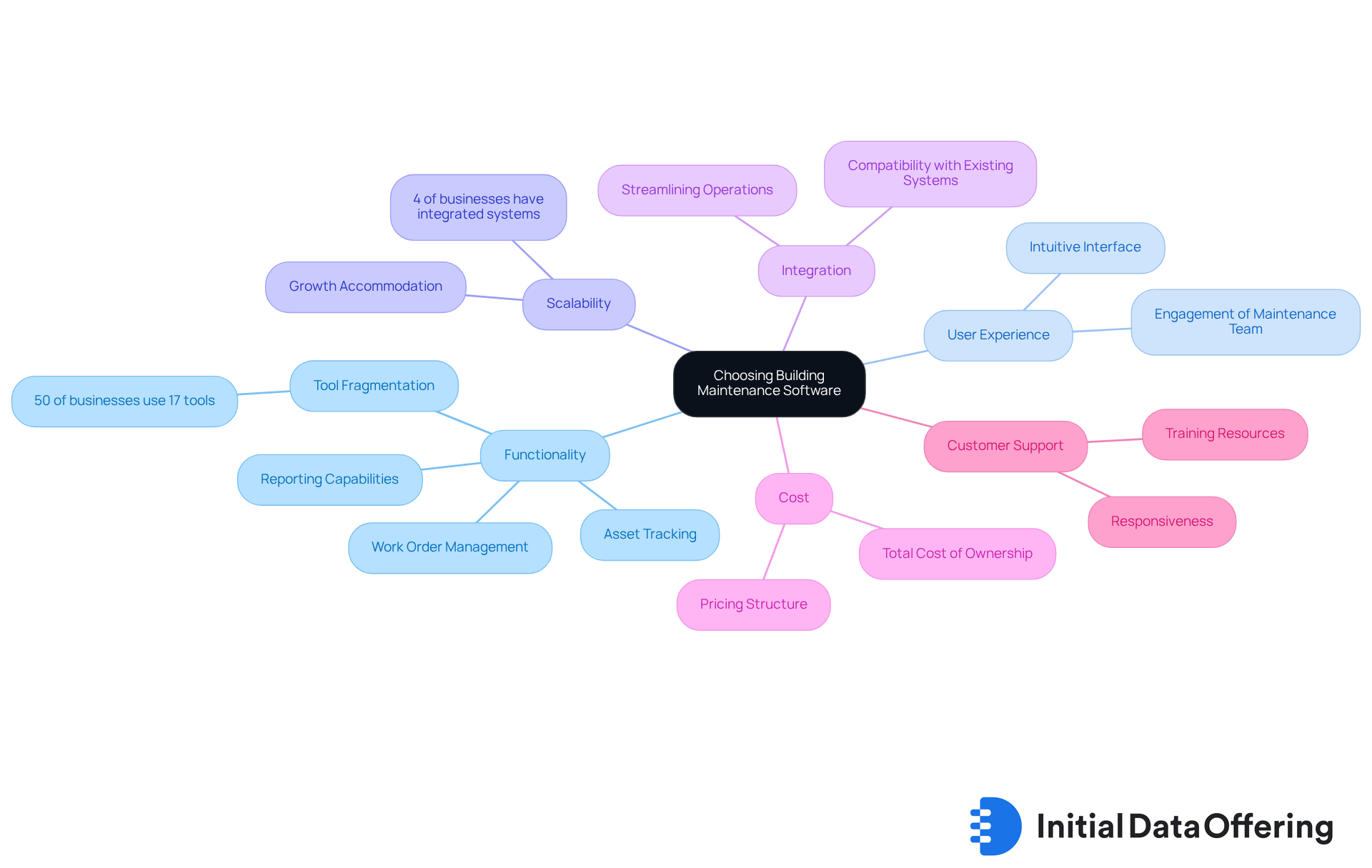Compare 2025’s Best Building Maintenance Software Solutions

Compare 2025’s Best Building Maintenance Software Solutions
Overview
The article provides an informative comparison of the best building maintenance software solutions for 2025, emphasizing their key features, user feedback, and overall performance. It highlights several leading options, including UpKeep and eMaint, detailing their unique strengths and functionalities tailored to various organizational needs. This analysis not only showcases the features of each software but also discusses the advantages they offer, such as improved operational efficiency and streamlined maintenance processes. By guiding users in selecting the most suitable software, the article ultimately aims to enhance their organizational effectiveness.
How can these software solutions transform your maintenance operations?
Introduction
Building maintenance software has emerged as a pivotal tool for organizations aiming to streamline their repair processes and enhance operational efficiency. With the facility oversight applications market experiencing significant growth, these solutions provide a wealth of features—from work order management to asset tracking—that promise to revolutionize maintenance practices.
However, as the array of options expands, how can organizations determine which software best meets their unique needs? This article explores the top building maintenance software solutions of 2025, examining their key features, advantages, and the critical factors to consider when making a selection.
Understanding Building Maintenance Software
Building maintenance software is essential for improving the organization of repair tasks across both commercial and residential properties. These applications offer a range of features, including:
- Work order coordination
- Asset tracking
- Preventive upkeep scheduling
- Comprehensive reporting
By automating these processes, organizations can significantly boost operational efficiency, minimize downtime, and ensure compliance with safety regulations. Notably, the facility oversight applications market is projected to grow from $3.79 billion in 2024 to $9.60 billion by 2033, underscoring the increasing reliance on these tools.
This application acts as a centralized platform for facility managers, enabling them to oversee upkeep activities, monitor service requests, and manage vendor communications effectively. For instance, a case study on computerized maintenance management systems (CMMS) demonstrated that implementing such programs led to substantial cost savings by automating tasks and preventing equipment failures through proactive upkeep. This forward-thinking approach not only reduces unexpected repairs but also prolongs the lifespan of assets, yielding measurable financial advantages.
Experts emphasize the importance of organizing work orders within building maintenance software. As Aaron George points out, "CMMS can directly solve all of these problems by centralizing information, automating tasks, and giving teams visibility into every aspect of facility operations." This capability is vital for upholding high standards of safety and efficiency in facility management, ultimately facilitating improved decision-making and resource allocation. As the complexity of facility operations increases, the adoption of building maintenance software is becoming increasingly critical for organizations aiming to enhance their operational efficiency.

Key Features of Leading Building Maintenance Solutions
Leading building maintenance software solutions usually include several key features that significantly enhance operational efficiency.
- Work Order Management: This feature facilitates the creation, assignment, and tracking of maintenance tasks, ensuring that all activities are organized and easily accessible.
- Asset Management: It allows users to monitor the condition and performance of equipment and facilities, which is crucial for maintaining optimal operations.
- Preventive Upkeep Scheduling: Automating the planning of regular servicing activities helps avoid equipment failures, leading to reduced downtime.
- Inventory Management: By tracking spare parts and supplies, this feature ensures that necessary materials are available when needed, preventing delays in maintenance.
- Reporting and Analytics: This function offers insights into upkeep activities, costs, and asset performance, enabling data-informed decision-making that can lead to better resource allocation.
- Mobile Accessibility: Many solutions provide mobile applications, allowing support teams to access information and update tasks while on the move, thus enhancing responsiveness.
These features not only enhance operational efficiency but also contribute to cost savings and improved service delivery. How might these capabilities transform your maintenance processes? By integrating building maintenance software, organizations can streamline their operations and foster a proactive maintenance culture.

Comparative Analysis of Top Building Maintenance Software for 2025
In 2025, several building maintenance software solutions distinguish themselves through their features, user feedback, and overall performance:
-
UpKeep: Known for its mobile-first design, UpKeep excels in work order oversight and preventive upkeep scheduling. This makes it ideal for organizations that prioritize mobile accessibility. Users appreciate its intuitive interface and real-time updates, which enhance communication and operational efficiency. One user noted, "Limble has made my life very easy and effective. Now, I can carry out my upkeep task on time, and if I forget, Limble is always there to remind me."
-
eMaint: Recognized for its robust reporting capabilities, eMaint offers comprehensive asset management features. It is especially designed for organizations looking to utilize data analytics for optimization, enabling informed decision-making and enhanced operational performance. A user remarked, "I believe there is no other tool on the market that delivers the same level of security, data capacity, and range of features as the Fiix system."
-
Trillium: This software is recognized for its on-demand facility repairs and preventive upkeep features, serving organizations that need quick response times. Its adaptability in handling urgent repair requirements makes it a strong competitor in the market.
-
MaintainX: With a user-friendly interface, MaintainX simplifies work order oversight, appealing to teams that need to streamline their maintenance processes without extensive training. Users have highlighted its effectiveness in enhancing task prioritization and documentation.
-
FMX: FMX stands out for its vendor management capabilities, making it suitable for organizations that collaborate with multiple service providers. Its characteristics enable effortless communication and monitoring of service requests, enhancing operational workflows.
Each of these solutions has unique strengths, and the best option will rely on particular organizational requirements, including facility size, task complexity, and budget factors. Furthermore, market share data suggests that UpKeep and eMaint are among the leading competitors in the market for building maintenance software in 2025, showcasing their popularity and efficiency in fulfilling user needs.

Choosing the Right Building Maintenance Software for Your Needs
When selecting building maintenance software, it is essential to consider the following criteria:
-
Functionality: Assess the specific features that are crucial for your operations, such as work order management, asset tracking, and reporting capabilities. Notably, 50% of businesses rely on an average of 17 separate worktech tools. This statistic highlights the significance of comprehensive functionality in reducing tool fragmentation.
-
User Experience: Look for applications with an intuitive interface that minimizes the learning curve for your team. Engaging your maintenance team in the assessment process can provide valuable insights into practical needs, ensuring that the system aligns with daily operational requirements.
-
Scalability: Ensure that the system can grow with your organization, accommodating increased users and functionalities as necessary. With only 4% of businesses having fully integrated systems, selecting scalable solutions that can connect with current tools is vital for long-term operational success.
-
Integration: Verify if the program can connect with existing systems, such as accounting or project coordination tools, to enhance operations. Computerized management systems (CMMS) focus on upkeep tasks, streamlining work orders and tracking assets, which ultimately enhances operational efficiency.
-
Cost: Evaluate the pricing structure, including any hidden fees for additional features or user licenses. Consider the total cost of ownership (TCO), which encompasses initial expenses and ongoing support charges, to ensure the application remains economical over time.
-
Customer Support: Consider the level of customer support offered, including training resources and responsiveness to inquiries. Reliable vendor assistance is crucial for resolving issues quickly and ensuring a seamless application experience.
By thoroughly assessing these factors, organizations can select building maintenance software that not only meets their current requirements but also facilitates future growth and efficiency. Engaging with facility management consultants can further enhance this process, as they often emphasize the importance of aligning software capabilities with organizational goals and user experience.

Conclusion
Building maintenance software serves as an essential resource for organizations striving to enhance operational efficiency and streamline maintenance processes. By centralizing tasks such as work order management, asset tracking, and preventive upkeep scheduling, these solutions not only improve coordination but also promote a proactive maintenance culture. This shift can lead to substantial cost savings and prolonged asset lifespans.
The article delineates key features of leading building maintenance software solutions, including:
- Mobile accessibility
- Robust reporting capabilities
- Inventory management
Specific software options like UpKeep, eMaint, and MaintainX are highlighted, showcasing how these tools address diverse organizational needs—from quick response times to comprehensive data analytics. Moreover, the importance of selecting software based on functionality, user experience, scalability, integration, cost, and customer support is emphasized, providing a clear framework for informed decision-making.
Ultimately, investing in the appropriate building maintenance software transcends merely meeting operational demands; it represents a transformation in how organizations manage their facilities. By embracing these advanced tools, businesses can enhance efficiency, ensure compliance with safety regulations, and improve overall service delivery. As the facility oversight applications market continues to grow, now is the opportune moment for organizations to assess their options and take proactive measures toward optimizing their maintenance strategies.
Frequently Asked Questions
What is building maintenance software?
Building maintenance software is a tool designed to improve the organization of repair tasks across commercial and residential properties, offering features like work order coordination, asset tracking, preventive upkeep scheduling, and comprehensive reporting.
How does building maintenance software improve operational efficiency?
By automating processes such as task management and scheduling, building maintenance software minimizes downtime, boosts operational efficiency, and ensures compliance with safety regulations.
What is the projected growth of the facility oversight applications market?
The facility oversight applications market is projected to grow from $3.79 billion in 2024 to $9.60 billion by 2033.
How does building maintenance software benefit facility managers?
It acts as a centralized platform for facility managers, allowing them to oversee upkeep activities, monitor service requests, and manage vendor communications effectively.
What are the financial advantages of using computerized maintenance management systems (CMMS)?
Implementing CMMS can lead to substantial cost savings by automating tasks, preventing equipment failures through proactive upkeep, reducing unexpected repairs, and prolonging the lifespan of assets.
Why is organizing work orders important in building maintenance software?
Organizing work orders is crucial as it centralizes information, automates tasks, and provides teams with visibility into facility operations, which helps maintain high standards of safety and efficiency.
How does building maintenance software facilitate decision-making?
By providing centralized information and visibility into every aspect of facility operations, building maintenance software enhances decision-making and resource allocation for facility managers.
Why is the adoption of building maintenance software becoming critical for organizations?
As the complexity of facility operations increases, adopting building maintenance software is essential for organizations looking to enhance their operational efficiency and effectively manage maintenance tasks.